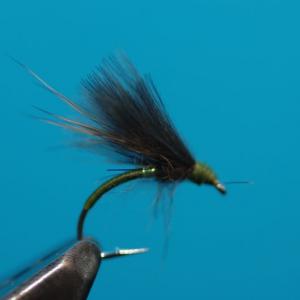
Cul de Canon
This is another great fly from Gwilym Hughes and, in fact, is the pattern that won him honours at the 1998 River International on the River Tweed, and also ensured that Wales were overall champions.
The fly was inspired by the Greenwell’s Glory and was named by a schoolmaster by the name of Brown after he saw James Wright tying them for Canon Greenwell. The Canon had seen BWO coming off the River Tweed and, having taken a sample, designed the first Greenwell’s Glory.
Whilst at practice during 1998, Gwilym also saw the hatching of the same Olive and set about designing a fly with Canon Greenwell’s original thoughts in mind, but using more modern materials. I know Cotton discusses that he used CDC plumes in his own flies.
With all these thoughts in mind, the Mark I Cul de Canon was born. The dressing of this fly is detailed below.
- Hook: Tiemco 2487 size 16
- Body: Lureflash primrose multi-strand silk code number MS6 drawn through brown cobblers wax.
- Wing: Four CDC plumes over 6 to 10 deer hair tips.
Gwilym was the individual winner and caught the biggest fish at 44.5cm during the competition.
The fly pattern has been further developed and the Mark II version is the one that I have tied on the video to imitate a small dark olive. The dressing is as follows:
- Hook: Kamasan B100 or similar, size 16 or to suit the hatch.
- Body: Olive silk or to match the hatch.
- Thorax: In two parts. First, three turns of pearl tinsel over itself followed by a dubbing loop of either rabbit fur or mole fur.
- Underwing: 6 to 10 fibres of dear hair tips (I have used muntjac in the video).
- Overwing: Four CDC plumbs.
Give the fly a try and tie it in different sizes and different coloured silks.


